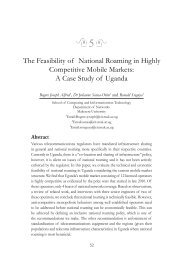Undergraduate Handbook - School of Computing and Informatics ...
Undergraduate Handbook - School of Computing and Informatics ...
Undergraduate Handbook - School of Computing and Informatics ...
You also want an ePaper? Increase the reach of your titles
YUMPU automatically turns print PDFs into web optimized ePapers that Google loves.
connections <strong>and</strong> scripts in order that one or more servers can share data from one or more data sources; Integrate<br />
databases which are dissimilar in structure, platform <strong>and</strong> DBMS.<br />
Indicative Content: HTML; Scripting languages; Server side scripting architecture <strong>and</strong> building dynamic web<br />
applications; Web development in any language, including Visual Basic, C++, <strong>and</strong> J++ programming; Integrative<br />
technologies e.g. XML technologies <strong>and</strong> protocols<br />
Reference Books:<br />
i. M. Wilson <strong>and</strong> T. Wilson, XML Programming with VB <strong>and</strong> ASP.<br />
ii. B. Brogden et al, Java Developers Guide to E-Commerce with XML <strong>and</strong> JSP.<br />
CSC 2111 Database Management Systems I (3 CU)<br />
Course Description: This course is to provide students with a strong foundation in systematic approaches to design<br />
<strong>and</strong> implementing <strong>of</strong> database applications. Preliminarily, operations like requirements gathering <strong>and</strong> database<br />
planning will be covered. The course will also introduce students to developing <strong>of</strong> application Programmes that talk<br />
to the database. These applications may be online or <strong>of</strong>fline. The aims <strong>of</strong> the course are to: Provide a background for<br />
the evolution <strong>of</strong> database (management) systems; Provide the students with the steps one has to go through when<br />
developing good database applications; Give h<strong>and</strong> on experience <strong>and</strong> knowledge in developing database (driven)<br />
applications<br />
Indicative Content: Background to databases; Evolution <strong>of</strong> database systems; Database organization <strong>and</strong><br />
architecture; Data base models; Over view <strong>of</strong> database application development; The database development life<br />
cycle; Database design; Conceptual design; Logical design; Physical Design; Querying databases; SQL/PL SQL<br />
<strong>and</strong> Scripting.<br />
Reference Books:<br />
i. T. Connolly <strong>and</strong> C. Begg, Database Solutions, 2nd Edition.<br />
CSC 2200 Operating Systems (3 CU)<br />
Course Description: This course introduces students to s<strong>of</strong>tware that controls hardware <strong>and</strong> makes the hardware<br />
usable. Its interaction with other computer devises <strong>and</strong> how it controls other computer processes is explored. The<br />
course aims to: Provide students with a detailed underst<strong>and</strong>ing <strong>of</strong> how operating systems work; Provide students<br />
with skills to write basic Programmes to utilize underlying operating system infrastructures. The dominant<br />
categories <strong>of</strong> operating systems are Windows <strong>and</strong> UNIX (Linux, Mac OS, Solaris, etc). On completion <strong>of</strong> this course<br />
unit, the students will be able to: Have a proper underst<strong>and</strong>ing <strong>of</strong> the differences between these two operating<br />
systems Underst<strong>and</strong> different design principles for operating systems <strong>and</strong> various s<strong>of</strong>tware tools that make operating<br />
systems usable.<br />
Indicative Content: Operating Systems Structures; Processes <strong>and</strong> threads; Thread creation, manipulation <strong>and</strong><br />
synchronization; Deadlock; Implementing Synchronization operations; CPU scheduling; Memory management; File<br />
systems <strong>and</strong> file system implementation; Monitors; Segments; Disk Scheduling; Networking; UDP <strong>and</strong> TCP.<br />
Reference Books:<br />
i. W. Stallings, Operating Systems: Internals <strong>and</strong> Design Principles, 4th edition, 2007.<br />
BIT 2201 Marketing in the IT Sector (3 CU)<br />
Course Description: A marketing orientation drives strategic decision-making in most companies today. The<br />
business press is constantly discussing the efforts <strong>of</strong> companies to get close to their customers or to meet their needs<br />
better than the competition. Indeed, it is impossible to underst<strong>and</strong> the current <strong>and</strong> potential financial success <strong>of</strong><br />
companies today without a thorough underst<strong>and</strong>ing <strong>of</strong> their target markets, customer relationships, product<br />
development skills, <strong>and</strong> competitive advantages <strong>and</strong> disadvantages. Marketing is all about creating <strong>and</strong> capturing<br />
value. By providing superior value to customers, companies enhance their own value. The marketing concept is so<br />
pervasive in companies that a marketing orientation extends well beyond the marketing department. Marketing has<br />
75

















